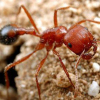I have recently started breeding mealworms and all of them are beetles now. Last week I saw some mating and yesterday, I also saw a female laying eggs. So I expect to see some nymphs, babies, larvae, or whatever their called, hatching.
- Formiculture.com
- Forums
- Gallery
- Members
- Member Map
- Chat






















